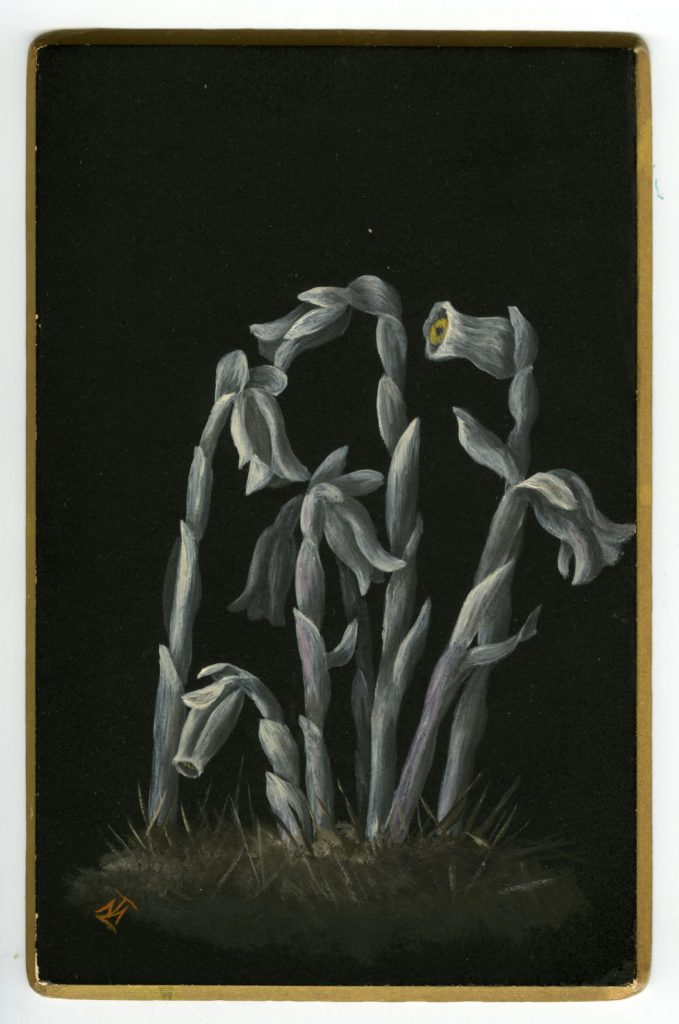In Search of the Mysterious Ghost Pipe (Monotropa uniflora L.)
The last time you walked through the St. Olaf Natural Lands what did you pay attention to?
If you walked through in August maybe you were in awe of the blooming wildflowers carpeting the prairie. If you enjoyed some walks through the woods last October maybe you remember the golden leaves glistening in the fall sun. If anyone was brave enough to endure the freezing January days they may have brought a pair of sunglasses to shield their eyes from the reflection of the sparkling white blanket. At every time of the year, there are wonders to enjoy walking our favorite trails, and even those of us who spend copious amounts of time exploring find new life every time.
I am admittedly one of those people who spends copious amounts of time weaving through the prairie and woods, popping out of the undergrowth every once in a while startling my fellow wanderers or trail runners. This past week my wanderings took me in search of the inconspicuous Ghost Pipe (Monotropa uniflora L.). A rare sighting, this plant only emerges from below ground for one week out of the year, blooming within the window of June-September. What makes this plant worthy of a 5-hour excursion into the depths of the forest is its unique color and the way in which it obtains nutrients. Monotropa uniflora does not boast the green pigment we attribute to our plant friends. No, this plant is completely white. After all, it spends most of its time under our feet, so what good would chlorophyll do anyway!? Without chlorophyll, the compound responsible for helping to absorb energy from the sun and produce carbohydrates through the process of photosynthesis, Monotropa uniflora has evolved an interesting relationship with the network of organisms under the soil that we rarely pay attention to. Reaching downwards, the plant acquires nutrients and carbohydrates from the trees, working hand in hand with mycorrhizal fungi (primarily in the genera Russula and Lactarius) to “steal” from surrounding plants.
While in search of this mysterious plant that is yet to be seen in the St. Olaf Natural Lands, I found myself paying attention to a whole new community in the forest I had wandered many times before. Beginning in some of our restored forests, tracing areas where I knew other related plants grew, I was struck by the difference along the forest floor when I eventually entered some of the remnant forest sections. I found myself aging some of the restored sections by the life I was noticing, and becoming excited to see small groups of plants such as Arisaema triphyllum (Jack in the Pulpit) and Caulophyllum thalictroides (Blue Cohosh) that are thriving in some of the existing forest sections but are scarce among the restored areas because of the timeline of succession and undergrowth in these areas. I found a variety of fungi including Ash-tree bolete, Aborted Entoloma, and a variety of artist’s brackets. I noticed differences in the humus layers of these forests that differed in age and told stories about the decomposition of past life. My time walking through the older woods was less impeded by young woody growth that made me bob and weave through the younger restored areas. I walked differently because even though I never left hardwood forests, I walked through time.
I never ended up finding Monotropa uniflora, but no time spent wandering in the Natural Lands is ever time lost. You will always find something new if you only pay attention. If you are like me, and itching to find some Ghost Pipe (Monotropa uniflora), I invite you to comb through some of the old-growth areas of our Natural Lands where the mycorrhizal networks are most highly established. It loves areas of mature, moist, shaded, and humus-rich forests. Only 4-8 inches tall, these plants may be small but generally grow in clusters that make them easier to spot. Keep your eyes peeled for life in areas where you wouldn’t think to look for a plant. The corners that don’t have the blooming yellow, purple, or red flowers – but have something arguably more astonishing just under our feet.
*Other recent spottings of Monotropa uniflora in the greater Northfield area include Caron Park, Nerstrand State Park, and other local natural areas. Check iNaturalist for exact locations, but remember to be respectful of the area and look but do not disturb! Happy trails!

“I still cherish the clutch with which I bore it from the ground when a wondering child, and unearthly booty, and maturity only enhances the mystery, never decreases it.”
Emily Dickinson (called Monotropa uniflora the “Preferred flower of life”)
You must be logged in to post a comment.